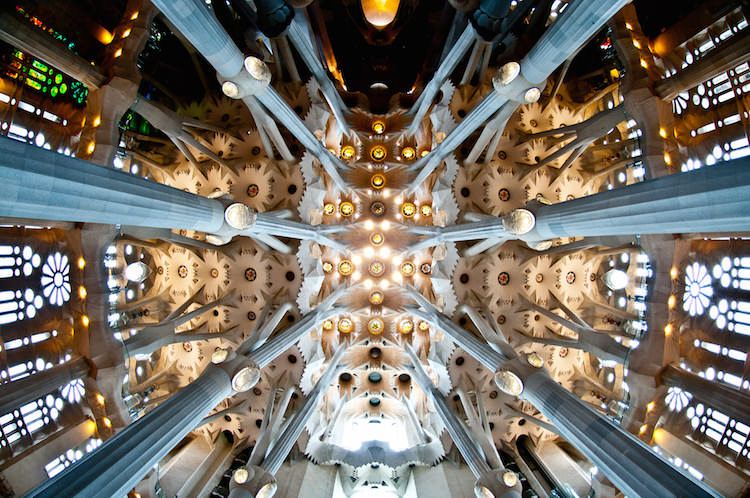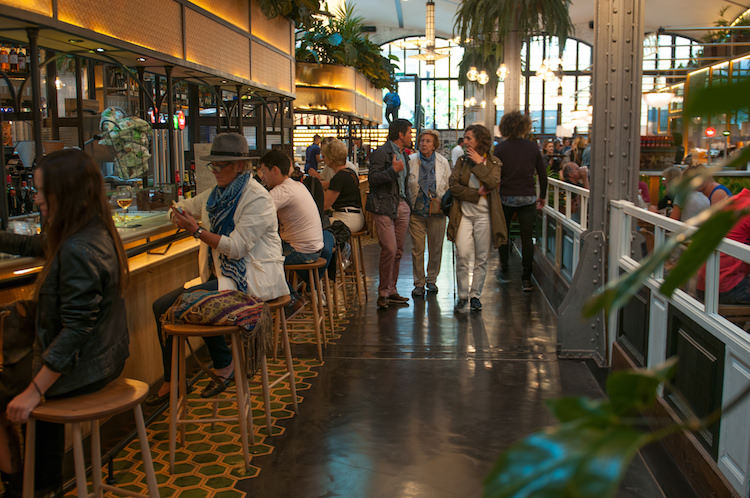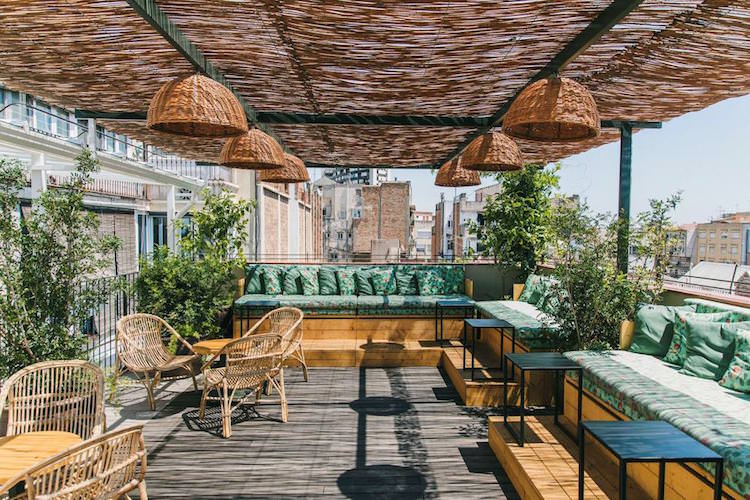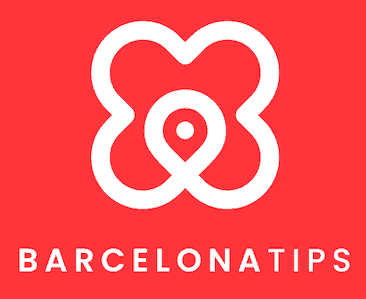Those who want to immerse themselves in Catalan modernism, the movement to which Antoni Gaudí, among others, made an important contribution, are guaranteed to get their money’s worth in the Eixample district (or rather the district). Foodies, fashionistas and art lovers will not be bored here either: Eixample is full of hip restaurants, beautiful stores and art galleries.
Contents
- The different neighborhoods of Eixample
- Top 5 things to see and do in Eixample
- Eating and drinking in Eixample
- Shopping in Eixample
- Staying overnight in Eixample
- All Eixample addresses on the map
- History of L’Eixample
- Eixample now – what can you expect?
The different neighborhoods of Eixample
Eixample is the district for those who love Catalan modernism. The district can be roughly divided into Eixample Esquerra (Eixample-left) and the older Eixample Dreta (Eixample-right) with the chic Passeig de Gràcia in the middle. This is now Spain’s most expensive shopping street where all the designer brands that matter are represented.
However, there are more neighborhoods in Eixample, here is an overview of all the barrios.
La Dreta de l’Eixample
Here are some of Barcelona’s most visited sights: among others, Casa Milà and Casa de les Punxes (I lived next door for a while!). Also sitting here is the famous shopping street Passeig de Gràcia and furthermore you can find many good restaurants here, think El Nacional for example, and there are many hotels.
What? – Architectural delights, fine restaurants and good shopping.
How to get there? – Metro stops: Verdaguer (L2/L5), Diagonal (L3/L5), Passeig de Gràcia (L2/L3/L4), Tetuan (L2), Girona (L4).
Main sights – Casa Milà, Casa de les Punxes, Passeig de Gràcia.
L’Antiga Esquerra de l’Eixample
This neighborhood, along with La Nova Esquerra de l’Eixample, used to be simply L’Esquerra de l’Eixample, which was later split into two parts. This neighborhood contains many modernist buildings, including Casa Batlló, and nice, cozy shopping streets. An example is the Rambla de Catalunya, which is actually an extension of the La Rambla, where you stroll between terraces past exclusive stores and chocolatiers that have often been established there for generations.
The lively Carrer d’Enric Granados street, with its mix of traditional and trendy restaurants and bars, from sushi to Italian, is also worth a visit. For example, visit Leo Messi’s restaurant, Bellavista del Jardín del Norte. And Robata, where you can sit down for sushi and grill dishes. The menu at Bardot is not extensive, but offers something for everyone, rice dishes, fish, luxury meat dishes, as well as “just” a burger.
The little traffic in the street has helped to ensure that many stores have settled here as well. And one store is more beautiful than another. For example, Cotton Vintage (luxury vintage items) and Deu i Deu, a fantastic interior design store.
In terms of attractions, the Universitat de Barcelona and the Museu del Modernisme are in this neighborhood. Otherwise, this is mostly a residential area where many locals live.
What? – A real residential area with beautiful modernist buildings. Also some nice shopping streets.
How to get there? – Metro stops: Hospital Clínic (L5), Urgell (L1).
Main sights – Casa Batlló, Rambla de Cataluyna, Universitat de Barcelona, Museu del Modernisme.
La Nova Esquerra de l’Eixample
This is a real residential area where not too many tourists come. In this district there are some attractions: the Plaça d’Espanya and, of course, the Las Arenas shopping center. The Joan Miró park is also located in this district.
What? – A real residential neighborhood with few tourists.
How to get there? – Metro stops: Entença (L5), Rocafort (L1).
Main sights – Plaça d’Espanya, Las Arenas, Joan Miró.
La Sagrada Família
This neighborhood surrounds Gaudí’s famous cathedral, the Sagrada Família, the highlight and an absolute must-visit during your trip to Barcelona. If you do go to the Sagrada Família (don’t forget to book online!), also stroll along the Avinguda de Gaudí to the nearby Hospital de la Santa Creu i Sant Pau, the masterpiece of architect Domènech i Montaner (who also designed the Palau de la Música in the El Born neighborhood).
What? – Neighborhood around Gaudí’s famous cathedral, the highlight of Barcelona.
How to get there? – Metro stops: Sagrada Familia (L2/L5), Sant Pau Dos de Maig (L5), Encants (L2), Monumental (L2).
Main sights – La Sagrada Família, Hospital de la Santa Crue i Sant Pau.
Sant Antoni
Sant Antoni is the place to enjoy a delicious brunch or have a nice coffee in one of the neighborhood’s many hip coffee bars. Foodie street Carrer del Parlament is extremely popular among locals and here you are guaranteed to eat well. You can also find the famous Sant Antoni market here. I come here regularly to do my shopping.
What? – Hip and upcoming. The neighborhood for foodies.
How to get there? – Metro stops: Sant Antoni (L2), Rocafort (L1), Paral.lel (L2/L3), Universitat (L1/L2), Urgell (L1), Poble Sec (L3).
Main sights – Markt Sant Antoni, Carrer del Parlament.
El Fort Pienc
On the border of this district is the Arc de Triomf and the city park La Ciutadella is also nearby. Otherwise, El Fort Pienc has no real attractions and is mainly a residential area where mainly families with children feel completely at home.
What? – Particularly popular with young families. Relatively quiet neighborhood, close to city park and downtown.
How to get there? – Metro stops: Arc de Triomf (L1), Marina (L1), Tetuan (L2), Monumental (L2).
Main sights – Arc de Triomf, La Ciutadella.
Top 5 things to see and do in Eixample
1. Sagrada Família (La Sagrada Família)


The highlight of Barcelona is located in the Eixample district, in the Sagrada Família neighborhood of the same name. The famous cathedral is still unfinished. A visit to see the inside is a real must!
2. Casa Milà (La Pedrera)


Casa Milà is considered an absolute masterpiece of Antoni Gaudí. Along with Casa Batlló, it is one of the two houses the architect designed on the Passeig de Gràcia. This building was soon nicknamed “La Pedrera” meaning quarry.
3. Casa Batlló (L’Antiga Esquerra de l’Eixample)


Gaudí’s second work on the Passeig de Gracià is Casa Batlló. This is another architectural masterpiece and definitely worth a visit! Next to Casa Batlló is Casa Amatller designed by Josep Puig i Cadafalch, a contemporary of Antoni Gaudí.
4. Shopping center Las Arenas (La Nova Esquerra de l’Eixample)


I certainly don’t mention the highlight Las Arenas necessarily for shopping, but rather because of the building itself and the 360º views from the rooftop terrace, which you can enjoy completely for free. Among other things, you can see the MNAC and the magical fountains from atop this old bullfighting arena.
5. El Nacional (La Dreta de l’Eixample)


This is the largest restaurant you can find in Spain, or rather it is several restaurants in one. There used to be a parking garage here but it has been completely overhauled by interior design studio Lázaro Rosa Violán. The result is spectacular! You can come here all day to enjoy breakfast, brunch, lunch, dinner or just to have a drink. Highly recommended!
Eating and drinking in Eixample
Eixample is the neighborhood to enjoy delicious food, have a coffee in a trendy coffee bar or order a glass of wine with some tapas on the side. Here is an overview of some of the best places to eat or drink something in Eixample.
Drink coffee
Known as one of the best bakeries in Barcelona, Baluard is also definitely my favorite. Be sure to try the nut and dried fruit bread, it is divine! Heaven on earth for the sweet tooth can be found in Eixample. Pateleria Janasa bake delicious bread and pastries. They sell only gluten-free products.
When locals line up, it’s a good sign…. This is the case at Turris València. Bread, pastries, pizza crusts, delicious.
Roast Club Cafe has delicious coffees and sweet staff. Breakfast and lunch are also top-notch. For awesome latte art, head to Bonsai Coffee & Matcha, where, the name says it all, you can drink flavored coffee and matcha.
Lunch and drinks
The largest restaurant in Spain is El Nacional. Here you can go all day for breakfast, brunch, lunch, a cup of coffee and drinks. Fantastic brunches, fresh juices and dangerously delicious cake can be found at Brunch & Cake.



Dining
A personal favorite is Ciutat Condal. They have good tapas here at an affordable price. Speaking of tapas, the tapas restaurant in town is Cervecería Catalana. Beware: it is always crowded here and reservations are not possible. Definitely a good alternative if Cervecería Catalana is too busy is Colmado. Much more locals, cozy atmosphere and good tapas!
Petit Bangkok is one of the better Thai restaurants in Barcelona. In addition, concept store and restaurant Jaime Beriestain Concept Store & Café is very cool. This is by successful interior designer Jaime Beriestain.
Drinks
At Bar Cosmo, they have good cocktails, changing art exhibitions and good food (though not necessarily Spanish). A true cocktail classic is Dry Martini. Renowned cocktail maker Javier de las Muelas is the owner. You can take a seat at the wooden bar and be served traditional cocktails.
Shopping in Eixample
The Eixample district is home to two major shopping streets, the aforementioned Passeig de Gràcia and Rambla de Catalunya. These are the shopping areas of the district. By the way, there are a few more spots that are definitely worth a visit. A tip, do not shop near the Sagrada Familía, there is not much to do here for shopaholics and besides, you will pay too much for your magnet or fingertip.



Fun shopping streets Eixample
Passeig de Gràcia
On the Passeig de Gràcia you will find many luxury brands like Chanel, Prada and Gucci, but also more affordable brands like COS, Other Stories, Zara and H&M are located on this street.
Rambla de Catalunya
Parallel to the Passeig de Gràcia is the Rambla de Catalunya, which starts practically from the Plaça de Catalunya. Here you will also find chains like Zara and Mango, but you will also find the Japanese store Muji and soap store Lush. Furthermore, you will find many delicatessens, where the most delicious cakes, cheeses and Spanish meats are sold.
Carrer d’Enric Granados
The atmospheric Carrer Enric Granados is also home to several nice boutiques and art galleries.
Las Arenas
This converted bullfighting arena has now become a true shopping paradise, but note that it does not house Inditex stores (Zara, Bershka, etc.). You can grab a bite to eat at one of the restaurants found on the rooftop terrace. Here, by the way, you can also enjoy the 360° view of the MNAC and the magical fountains, among others, for free. Shopping in the Arenas can also be combined with a visit to the hill de Montjuïc.
Mercat de Sant Antoni
The Sant Antoni fresh market is a good place to stock up on delicacies. This is also where my favorite supermarket is located: Casa Ametller.
Staying overnight in Eixample
The Eixample district has many hotels as it is centrally located in the city. Below is an overview of the nicest and coolest hotels and apartments.
Hotels in Eixample
Hotel Praktik Vinoteca

In the middle of the Eixample district near the Rambla de Catalunya and Passeig de Gràcia lies this fine and popular three-star hotel. Hotel Praktik Vinoteca is 700 meters from Plaça de Catalunya, the heart of the city. Beautiful, soundproofed rooms, sleekly decorated and with wooden floors and private bathrooms. The hotel has lovely sitting areas, where of course you will have a glass of wine!
Prices, reviews, current information and availability: Hotel Praktik Vinoteca
Pension Casa del Mediterraneo

In the Carrer d’Enric Granados, perhaps the coziest street in the Eixample neighborhood, is this, for Barcelona standards, inexpensive guest house Casa del Mediterraneo. Simple but nice rooms, which do not have air conditioning, but do have central heating. You share the bathroom with other guests. The guesthouse also includes a terrace and a lounge area. Personal service. A good option if you don’t want to spend too much on your overnight stay.
Prices, reviews, current information and availability: Pension Casa del Mediterraneo
Hotel Casa Bonay

Hotel Casa Bonay in the Eixample neighborhood is more of a concept than a hotel. Everything here, from the furniture to the staff’s clothing, is made by local designers. The lounge is a great place to start – or end – your day, but the rooftop terrace is also super. The sleek designer rooms are on the small side, but some have a small terrace. The hotel includes a good coffee bar and a restaurant.
Prices, reviews, current information and availability: Hotel Casa Bonay
Hotel Sir Victor

On Barcelona’s most expensive shopping street, the Passeig de Gràcia, you will find the chic and luxurious Hotel Sir Victor. From the rooftop terrace you have a beautiful view of the city and its “neighbors,” Casa Milà, one of the Antoni Gaudí-designed houses on the street. You can also take a dip in the pool(s) here. In addition to hotel guests, locals and other tourists like to use the rooftop bar. The same goes for the luxurious spa and the club, where funk and soul music blares from the boxes on weekends. The breakfast is extensive, the beds comfortable and the rain shower more than welcome after a long day in the hot city.
Prices, reviews, current information and availability: Hotel Sir Victor
Apartments in Eixample
Flat Top Manger

Ideal for a group of friends or two families, for example. This large apartment in the Eixample district is bright, spacious and modern and is close to Urgell metro station and the El Raval district. There are four double beds and two single beds. The bathroom does not have a bathtub, but it does have a wonderful shower. Both the living room and the kitchen have tables for extensive dining.
Prices, reviews, current information and availability: Flat Top Manger
Apartments Sixty Four

This spacious, open-plan, designer apartment features two bedrooms, one with a double bed and one with two single beds. It is right across from Casa Batlló on Passeig de Graçia and a few minutes’ walk from Plaça de Catalunya. There is a large equipped kitchen with dishwasher and a beautiful bathroom. You can also use the free wifi throughout the apartment.
Prices, reviews, current information and availability: Apartments Sixty Four
Fisa Rentals Gran Via Apartments

This apartment is ideal for a group of friends or two couples together on a city trip. There are two bedrooms, each with its own large bathroom. The first of the two bedrooms has a double bed, and the second bedroom has two single beds. There is also a large cozy living room with flat screen TV. The equipped kitchen has a dishwasher and there is also a washing machine.
Prices, reviews, current information and availability: Fisa Rentals Gran Via Apartments
Habitats Rambla Catalunya

Officially, this apartment is just in the Eixample neighborhood. Within two minutes you are on Plaça Catalunya and the Passeig de Gràcia, where you stumble over the (mostly luxury) stores. The Rambla de Catalunya itself also has plenty of nice stores and good restaurants. Prefer to cook yourself? That’s fine in the kitchen! You can choose between an apartment with two bedrooms with two single beds each, or three bedrooms with two single beds each.
Prices, reviews, current information and availability: Habitats Rambla Catalunya
All Eixample addresses on the map
All the addresses mentioned in this article can be found on the map below, the colors indicate the category!
Blue = sights
Yellow= restaurant
Green = shopping street
Orange = staying overnight
History of L’Eixample
When Barcelona was bursting at the seams in the mid-nineteenth century, it was time to tear down the city wall so the city could breathe again. That wall stood around the neighborhoods of El Gòtic, El Born and El Raval, also known as Ciutat Vella (the Old Town).
Construction began on L’Eixample, the Catalan word for “expansion. The neighborhood is easy to recognize on the map and from the air by its square blocks of houses, a model also found in cities such as Paris and New York.
The “cut corners” so typical of Eixample were to provide more fresh air and better visibility for the increasingly motorized traffic. Because of the cramped, dark streets of the old city, reminiscent of wars and the many diseases that broke out there due to the lack of hygiene and because of harsh poverty, there was an enormous need for space, light and quiet.
Plan Cerdà
Urban planner Ildefonso Cerdà designed a district with residential houses all no higher than four stories and in such a way that everyone could enjoy sunlight. It was also planned to have many social facilities, such as schools and hospitals, as well as traffic-free zones and public courtyard gardens. But not much came of the original plan, and under the influence of the wealthy elite, many of Cerdà’s ideals were swept off the table.
Public courtyards became private courtyards, and floor upon floor was built so that nothing came of more light. To get around the four-story rule, mezzanine floors were added to many buildings, which were then not named first or second floors, but, for example, entresol or principal.
Eixample now – what can you expect?
Eixample quickly became Barcelona’s largest neighborhood, today home to over 300,000 people and about 265,000 workplaces. Traffic races relentlessly through the streets and greenery is hard to find. In contrast, l’Eixample is one big open-air museum with one modernist gem after another.
And there is plenty of reason for optimism, as the municipality has been converting many of the courtyards into playgrounds and parks for some time now. Sidewalks on busy traffic routes are also being widened and more and more bike lanes are being added.
The latter, by the way, is also done to get Barcelonans to ride their bikes and thus contribute to reducing air pollution from the many exhaust fumes.


